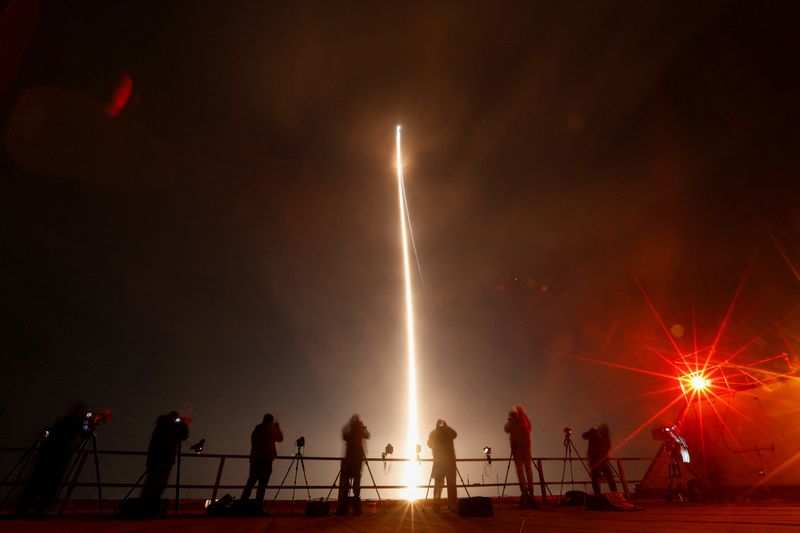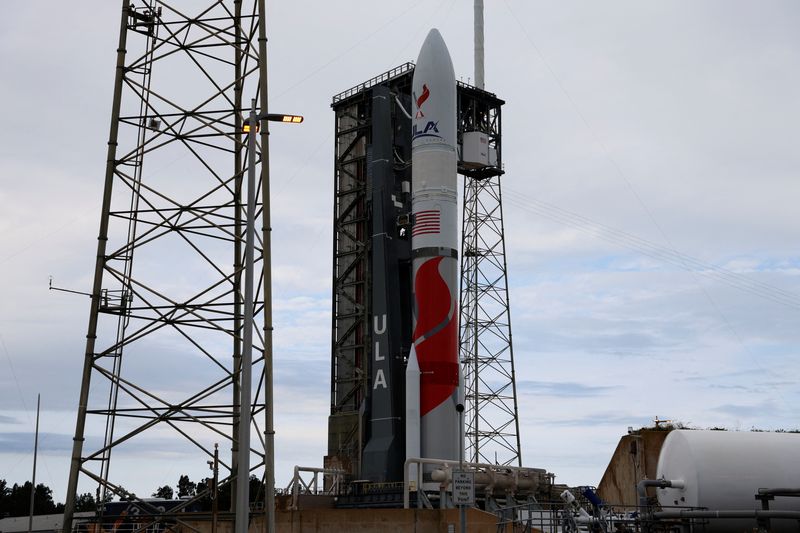By Joey Roulette
WASHINGTON (Reuters) -A robotic lander built by a private company suffered a propulsion system issue on its way to the moon on Monday, upending the first U.S. soft lunar landing attempt in over 50 years as mission managers scrambled to fix its position in space.
Space robotics firm Astrobotic Technology's Peregrine lunar lander had launched successfully to space at 2:18 a.m. ET from Cape Canaveral, Florida, aboard the first flight of Vulcan, a rocket that had been under development for a decade by the Boeing (NYSE:BA) and Lockheed Martin (NYSE:LMT) joint venture United Launch Alliance (ULA).
But hours after separating from Vulcan, Astrobotic said issues with Peregrine's propulsion system briefly prevented the spacecraft from angling itself toward the sun for power.
While mission engineers regained control, the faulty propulsion system is losing valuable propellant, forcing Astrobotic to consider "alternative mission profiles," suggesting a moon landing is no longer achievable.
The launch of Vulcan, a 200-foot (60-meter) tall rocket with engines made by Jeff Bezos' Blue Origin, was a crucial first for ULA, which developed Vulcan to replace its workhorse Atlas (NYSE:ATCO) V rocket and rival the reusable Falcon 9 from Elon Musk's SpaceX in the satellite launch market.
The stakes of the mission were high for Vulcan. Boeing and Lockheed, which own ULA in a 50-50 split, have been seeking a sale of the business for roughly a year. The launch was the first of two certification flights required by the U.S. Space Force before Vulcan can fly lucrative missions for the Pentagon, a key customer.
A successful launch of the moon lander, which ULA agreed to fly at a roughly 50% discount given the risks of flying on a new rocket, allows the company to start fulfilling a multibillion-dollar backlog of some 70 missions booked already. Vulcan sells for at least $110 million per launch.
Vulcan's placement of the Peregrine lander into orbit was "dead on bullseye," ULA CEO Tory Bruno said. "This has been years of hard work," he added from the company's launch control room after launch.
But the lander itself, after being released from the rocket, failed to enter its correct sun-facing orientation in space and saw its battery levels plummet, hours after it made successful contact with ground teams and activated its propulsion system, Astrobotic said in a statement.
As Astrobitc was working to confirm the propulsion system issue, it said such a problem "threatens the ability of the spacecraft to soft land on the moon."
It said in a later update that engineers had regained control of the spacecraft to allow it to charge its batteries. While Peregrine remains in Earth's orbit, "we have prioritized maximizing the science and data we can capture," Astrobotic said.
'MOMENT WE'VE BEEN WAITING FOR'
Setting off for a 46-day trek on Monday, Peregrine was poised to mark the first U.S. soft landing on the moon since the final Apollo mission in 1972, and the first-ever lunar landing by a private company - a feat that has proved elusive in recent years.
"This is the moment we've been waiting for for 16 years," Astrobotic CEO John Thornton said after the lander's launch.
The mission is the latest in recent years among countries and private companies sprinting to the moon, a renewed stage of international competition in which scientists hope the moon's water-bearing minerals can be exploited to sustain long-term astronaut missions.
Peregrine was set to land on the moon on Feb. 23 with 20 payloads aboard, most of which were designed to gather data about the lunar surface ahead of planned future human missions. If successful, it would mark the first trek to the moon's surface as part of NASA's Artemis moon program.
That multibillion-dollar program, involving various countries and relying heavily on private companies such as SpaceX, envisions astronaut missions to the moon later this decade. Small landers such as Peregrine are expected to get there first.
A second private U.S. company under the same NASA program expects to launch a lander of its own in February. Carrying similar NASA payloads and launching to space aboard a SpaceX Falcon 9, Houston-based Intuitive Machines' said its spacecraft could make a moon landing on Feb. 22, a day before Peregrine's planned arrival.

India last year became the fourth country to achieve a soft lunar landing after Russia failed in an attempt the same month. The U.S., China and the former Soviet Union are the only other countries that have carried out successful soft lunar landings.
Private companies with hopes of spurring a lunar marketplace have had harder times, with Japan's ispace and an Israeli company crash-landing on their first attempts.
